人教版高中英语必修2第4单元教(学)案
人教版(2019)新教材高中英语必修第二册第四单元词汇学案
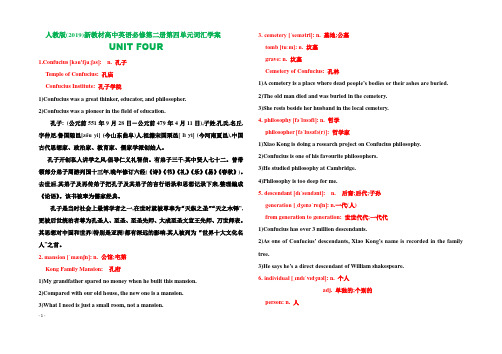
人教版(2019)新教材高中英语必修第二册第四单元词汇学案UNIT FOUR1.Confucius [kən'fjuːʃəs]: n. 孔子Temple of Confucius: 孔庙Confucius Institute: 孔子学院1)Confucius was a great thinker, educator, and philosopher.2)Confucius was a pioneer in the field of education.孔子: (公元前551年9月28日-公元前479年4月11日),子姓,孔氏,名丘,字仲尼,鲁国陬邑[zōu yì] (今山东曲阜)人,祖籍宋国栗邑[ lìyì] (今河南夏邑),中国古代思想家、政治家、教育家、儒家学派创始人。
孔子开创私人讲学之风,倡导仁义礼智信。
有弟子三千,其中贤人七十二。
曾带领部分弟子周游列国十三年,晚年修订六经(《诗》《书》《礼》《乐》《易》《春秋》)。
去世后,其弟子及再传弟子把孔子及其弟子的言行语录和思想记录下来,整理编成《论语》。
该书被奉为儒家经典。
孔子是当时社会上最博学者之一,在世时就被尊奉为“天纵之圣”“天之木铎”,更被后世统治者尊为孔圣人、至圣、至圣先师、大成至圣文宣王先师、万世师表。
其思想对中国和世界(特别是亚洲)都有深远的影响,其人被列为“世界十大文化名人”之首。
2. mansion [ˈmænʃn]: n. 公馆;宅第Kong Family Mansion: 孔府1)My grandfather spared no money when he built this mansion.2)Compared with our old house, the new one is a mansion.3)What I need is just a small room, not a mansion. 3. cemetery [ˈsemətri]: n. 墓地;公墓tomb [tuːm]: n. 坟墓grave: n. 坟墓Cemetery of Confucius: 孔林1)A cemetery is a place where dead people’s bodies or their ashes are buried.2)The old man died and was buried in the cemetery.3)She rests beside her husband in the local cemetery.4. philosophy [fəˈlɒsəfi]: n. 哲学philosopher [fəˈlɒsəfə(r)]: 哲学家1)Xiao Kong is doing a research project on Confucius philosophy.2)Confucius is one of his favourite philosophers.3)He studied philosophy at Cambridge.4)Philosophy is too deep for me.5. descendant [dɪˈsendənt]: n. 后裔;后代;子孙generation [ˌdʒenəˈreɪʃn]: n.一代(人)from generation to generation: 世世代代;一代代1)Confucius has over 3 million descendants.2)As one of Confucius’ descendants, Xiao Kong’s name is recorded in the family tree.3)He says he’s a direct descendant of William shakespeare.6. individual [ˌɪndɪˈvɪdʒuəl]: n. 个人adj. 单独的;个别的person: n. 人- 1 -people: n. 人; 民族1)An idiom is an expression which means something different from the meaning ofthe individual words.2)Sometimes I feel that individuals can have little effect on such hugeenvironmental problems.3)The museum is open to both teams and individuals.7. heel [hiːl]: n. 足跟; (脚/袜子/鞋等的)后跟Achilles’ [əˈkili:z] heel: (喻)(希腊神话)阿喀琉斯的脚跟; 致命的弱点1)English is his Achilles’ heel.2)Lucy’s Achilles’ heel is that she cannot believe in others.3)She will buy shoes with a low/high heel.阿喀琉斯的脚跟/之踵[zhǒng]阿喀琉斯, 是凡人英雄珀琉斯和海洋女神忒[tè]提斯的爱子。
人教版高一英语必修二Unit4 写作课 课程教学设计
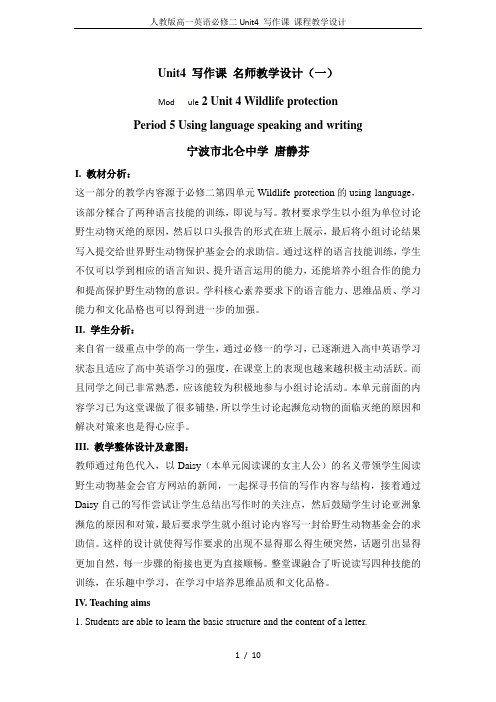
Unit4 写作课名师教学设计(一)Mod ule 2 Unit 4 Wildlife protectionPeriod 5 Using language speaking and writing宁波市北仑中学唐静芬I. 教材分析:这一部分的教学内容源于必修二第四单元Wildlife protection的using language,该部分糅合了两种语言技能的训练,即说与写。
教材要求学生以小组为单位讨论野生动物灭绝的原因,然后以口头报告的形式在班上展示,最后将小组讨论结果写入提交给世界野生动物保护基金会的求助信。
通过这样的语言技能训练,学生不仅可以学到相应的语言知识、提升语言运用的能力,还能培养小组合作的能力和提高保护野生动物的意识。
学科核心素养要求下的语言能力、思维品质、学习能力和文化品格也可以得到进一步的加强。
II. 学生分析:来自省一级重点中学的高一学生,通过必修一的学习,已逐渐进入高中英语学习状态且适应了高中英语学习的强度,在课堂上的表现也越来越积极主动活跃。
而且同学之间已非常熟悉,应该能较为积极地参与小组讨论活动。
本单元前面的内容学习已为这堂课做了很多铺垫,所以学生讨论起濒危动物的面临灭绝的原因和解决对策来也是得心应手。
III. 教学整体设计及意图:教师通过角色代入,以Daisy(本单元阅读课的女主人公)的名义带领学生阅读野生动物基金会官方网站的新闻,一起探寻书信的写作内容与结构,接着通过Daisy自己的写作尝试让学生总结出写作时的关注点,然后鼓励学生讨论亚洲象濒危的原因和对策,最后要求学生就小组讨论内容写一封给野生动物基金会的求助信。
这样的设计就使得写作要求的出现不显得那么得生硬突然,话题引出显得更加自然,每一步骤的衔接也更为直接顺畅。
整堂课融合了听说读写四种技能的训练,在乐趣中学习,在学习中培养思维品质和文化品格。
IV. Teaching aims1. Students are able to learn the basic structure and the content of a letter.2. Students are able to train their speaking ability and thinking ability through discussion in groups.3. Students are able to train their writing ability through independent writing, correcting others’ and polishing.4. Students are able to raise their awareness of wildlife protection.V. Important points and difficult points1. It’s important to help the students learn the structure and content of a letter and also important to train their speaking and writing ability.2. It’s difficult for students to get the entire content of the letter, especially appropriate reasons and solutions.VI. Teaching proceduresStep 1: lead-in1. Daisy’s self-introduction:“Hello,I’m Daisy! Still remember me? I’m the girl who is really concerned about endangered species.”2. Daisy’s good news:“Yesterday, I searched the official website of WWF and I saw the good news Learn about us and get fund. Wow! I’m interested in it. I’m eager to get involved! Let’s read the news together.”Learn about us and get fund!For more than 50 years, WWF has been protecting the future of nature. The world's leading conservation organization, WWF works in 100 countries and is supported by almost five million members worldwide.Now good news comes. We are going to offer 10% of our donation to some programs of worldwide conservation activities. If you want to help save some rare animals, please share with us their endangered situations and what you can do to protect them. Later we will estimate whether we should support them or not. Now take action and *************************************.设计意图:角色代入Daisy,使学生对老师更有一种亲近感,营造了朋友间的交流氛围和沟通模式,增加了师生间的互动。
高中英语人教版(2019)必修 第二册unit4 4.1 教案9

优质资料---欢迎下载Unit 4 History and TraditionsPeriod 1 ListeningSpeaking&Talking教学设计Listening and Speaking introduces the topic of “Take part in a youth project”.The listening text is an interview about "sharing views on historical sites". Through listening to a dialogue between Chinese and foreign students on the way to the Confucius Temple, students can understand their views on the Confucius Temple, Confucius, Confucius' descendants and Confucius' educational thoughts, so as to realize and think about the profound influence of Confucius and his thoughts on Chinese historical tradition. At the same time, the dialogue naturally integrates English idioms and mentions Shakespeare, the British playwright, so as to provide language materials and context for students to understand English idioms and related cultural allusions, as well as to compare Chinese and foreign cultures, which is helpful for students to understand and express the language such as history, tradition, culture and custom significant impact.Text analysis: listening text is a dialogue between a British student and a Chinese student when he goes to the Confucius Temple. When William, a British student, visited the Confucius Temple, he asked Xiao Kong, a Chinese student, for directions. Xiao Kong was just going to the Confucius Temple to meet with the members of the research group, so they went together and exchanged their views on the Confucius Temple, Confucius, Confucius' descendants and Confucius' educational thoughts. From the perspective of foreign tourists, this paper describes their thoughts on Confucius, the great son of Confucius, who had a profound impact on Chinese history and cultural tradition, and his education.Listening and Talking introduces a visit to a historic tourist destination. Tourism is a common way to understand a country's history, culture, and customs and so on. Students listen to the dialogue between Xiao Yan, a youth hostel Usher, and Paul, a backpacker, to learn about Pingyao's famous historical and cultural attractions and Paul's travel experience and experience as a foreign tourist.1. Guide students to understand the content of listening texts in terms of the whole and key details;2. Cultivate students' ability to guess the meaning of words in listening; discuss with their peers how to talk about historic spots and great person.3. Instruct students to use functional sentences of showing one’s excitement, surprise and disappointment.1. Guide students to understand the content of listening texts in terms of the whole and key details;2. Cultivate students' ability to discuss with their peers the related topics.3. Enable students to use the functional items of showing one’s excitement, surprise and disappointment.Part 1: Listening and SpeakingStep 1: Lead inShare views on historic sitesBefore you listen, look at some photos of Qufu. What can you say about these places?Temple of Confucius Kong Family Mansion Cemetery of ConfuciusStep 2: PredictionAfter their small talk, the teacher can ask students to predict what the listening text is about by looking at the pictures.The listening text is probably about the introduction of a great educator--ConfuciusStep 3:Listen to a conversation between a British tourist and a Chinese student in Qufu, and then write down what they say about Confucius.William’s opinions / facts about Confucius:1. He is one of his favorite __________.2. He was a __________man.3. He lived over _____years ago.Xiao Kong’s opinions / facts about Confucius:1. Confucius has over ___million descendants.2. He was a great ______and had many ideas about ________.3. He was one of the ___________minds in history.1. philosophers2. wise3. 25004. 3catorcation7.greatestStep 4: After finishing the task above, the teacher plays the same material again and after finishing listening, the students need to solve the following task.•1. Listen again and decide whether these statements are true(T), false(F), or not mentioned (NM).Then answer the question.•1. Confucius said that learning without understanding leads to confusion. F•2. Xiao Kong is doing a research project on Confucius philosophy. F•3. As one of Confucius' descendants, Xiao Kong's name is recorded in the family tree. NM•4. Dacheng Hall is the tallest building in Qufu. T•2. Why do you think William said his hometown was similar to Qufu?•His hometown doesn’t allow other __________________to be more ______________________than his historic buildings.Buildings /noticeableStep 5: Write down the English idioms that are used in the conversation. Explain their meanings and think about some Chinese equivalents.Listening tip:Step 6:Speaking ProjectWork in pairs or groups and role play a conversation.•Discuss the questions in groups.• 1. What do you know about Confucius' ideas on education? Think of two or three examples.• 2. What else do you know about Confucius and his philosophy?• 3. Think about a historic site that you have visited, and give an introduction to its history and importance. Part 2: Listening and TalkingStep1:Listen to the tape, which is about Pingyao ancient town for the first time, and then ask the students to solve the following tasks.Backpacker Paul is talking to a receptionist at an international youth hostel in Pingyao, China. Listen to the conversation and tick the places mentioned.•Ming-Qing Street•Ancient Government Office•Qiao Family Courtyard•Wang Family Courtyard•Rishengchang Bank•Mount Mian•the city wall•Zhengguosi Temple•Shuanglin TempleStep 2. Listen once more. Complete the sentences to describe how the speakers felt.•I had expected something different.•Paul sounded_________________________•It was like walking into history.•Paul sounded_________________________•It wasn't as big as I had expected.•Paul sounded_________________________•Some of the snacks there are amazing.•Xiao Yan sounded_________________________•I had no idea there would be so many tourists.•Paul sounded_________________________•Wow, I can't believe you didn't see the wall.•Xiao Yan sounded_________________________Step 3: Speaking ProjectWork in groups.Imagine one of you has just visited Pingyao. Work in pairs and role-play the conversation below. Then continue the conversation using the following expressions.Expressing excitement, surprise, and disappointmentA: Wow, I've just come back from Pingyao. It was amazing!B: Oh, I loved Pingyao! So did you see the Ming-Qing Street?A: Of course, but I didn't expect to see so many tourists.B: Yeah, I know what you mean, but there are some great snacks there. How about the ticket?A. It is not very dear about 125yuan. And the transport is very convenient. You can reach there by flight, car or bus.B. sounds cool. Anything else to share?A:Pingyao ancient city is the outstanding example of Chinese Han nationality cities during Ming and Qing Dynasties; remaining all features of such periods, Pingyao ancient city reveals-a picture of unexpected cultural social, economic and religious development in Chinese history. If you travel to this place, it will be unforgettable forever.B: I will absolutely go there.Homework:Work in groups.Take turns telling each other about a historic place that you have been to.。
高中英语(新人教版)必修第二册课后习题:UNIT 4 Section D(课后习题)【含答案及解析】
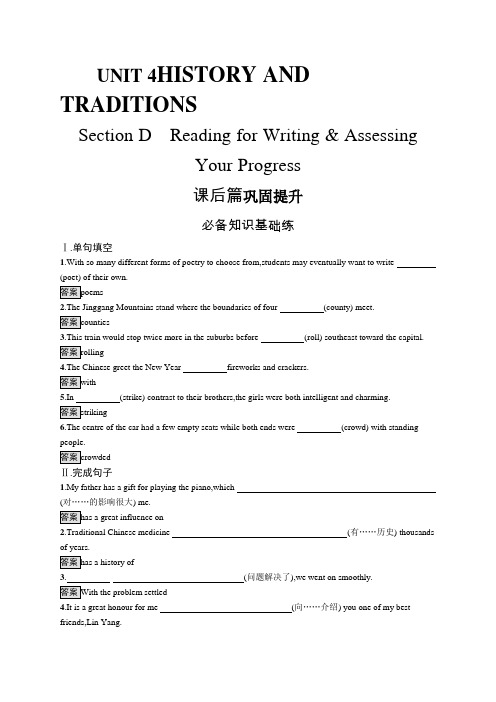
UNIT4HISTORY AND TRADITIONSSection D Reading for Writing&AssessingYour Progress课后篇巩固提升必备知识基础练Ⅰ.单句填空1.With so many different forms of poetry to choose from,students may eventually want to write (poet) of their own.2.The Jinggang Mountains stand where the boundaries of four (county) meet.3.This train would stop twice more in the suburbs before (roll) southeast toward the capital.4.The Chinese greet the New Year fireworks and crackers.5.In (strike) contrast to their brothers,the girls were both intelligent and charming.6.The centre of the car had a few empty seats while both ends were (crowd) with standing people.Ⅱ.完成句子1.My father has a gift for playing the piano,which(对……的影响很大) me.2.Traditional Chinese medicine (有……历史) thousands of years.3.(问题解决了),we went on smoothly.4.It is a great honour for me (向……介绍) you one of my best friends,Lin Yang.5.The lecture was so exciting that it (使我们情绪激昂).6.Mr Brown decided to (做更多的研究) and write a book about it.7.The article on this website(给我们许多背景信息).Ⅲ.翻译句子1.她最后变成了一个优秀的作家并不令人惊讶。
2019统编人教版高中英语必修第二册unit 4《History and traditions》全单元教案教学设计
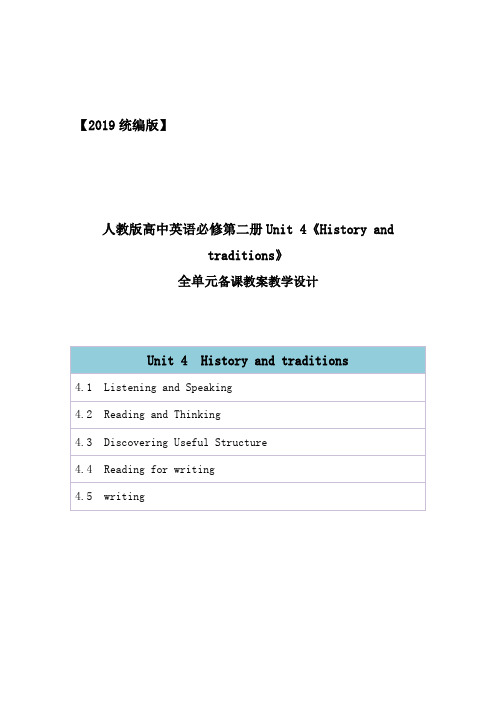
【2019统编版】人教版高中英语必修第二册Unit 4《History andtraditions》全单元备课教案教学设计Unit 4 HISTORY AND TRADITIONSListening and Speaking【教学目标】1. 掌握本课的重要词汇与句式;2. 引导学生通过课内听力训练,提高听力技巧,锻炼听力水平。
【教学重难点】1. 本课时的重要词汇与句式;2. 引导学生通过课内听力训练,提高听力技巧,锻炼听力水平。
【教学过程】Step 1 Lead inLook at the photo on Page 37, and then get the Ss to ask and answer the questions.1. What do you know about the buildings in the photo?2. What traditions of that city/country do you know about?3. Why is it important to protect historic buildings and cultural traditions?Then have some Ss share their views on the questions.Step 2 Share views on historic sites1. Before listening, get the Ss to look at some photos of Qufu in Activity 1 on Page 38. And ask “What can you say about these places?”Get the Ss to discuss in groups, and then ask several volunteers to share their views with the class.2. Listen to a conversation between a British tourist and a Chinese student inFinally check the answers with the class.3. Listen again and decide whether these statements are true (T), false (F), or not mentioned (NM).(1) Listen and judge, and check the answers.1) Confucius said that learning without understanding leads to confusion.2) Xiao Kong is doing a research project on Confucius philosophy.3) As one of Confucius’ descendants, Xiao Kong’s name is recorded in the family tree.4) Dacheng Hall is the tallest building in Qufu.(2) Then go through the question as bellow, and choose the right answer.·Why do you think William said his hometown was similar to Qufu?A. There are famous halls in his hometown.B. There are no tall buildings in his hometown.C. Both places have a famous person who was born there.D. His hometown doesn’t allow other buildings to be more noticeable than the historic buildings.4. Activity 4(1) At first, go through the Understand idioms with the Ss.An idiom is an expression which means something different from the meaning of the individual words. Some idioms present an idea or paint a picture that gives a hint as to the meaning. Other idioms can only be understood from the context in which they appear.(2) Write down the English idioms that are used in the conversation. Explain their meanings and think about some Chinese equivalents.5. Discuss the questions in groups, and then get some Ss to share their answers.(1) What do you know about Confucius’ ideas on education? Think of two or three examples. What else do you know about Confucius and his philosophy?(2) Think about a historic site that you have visited, and give an introduction to its history and importance.Step 3 Pronunciation1. Read this part of the poem “If-” written by British poet Rudyard Kipling.Notice the linking sounds. Then mark the linking sounds after the modelIf you can make one heap of all your winningsAnd risk it on one turn of pitch-and-toss,And lose, and start again at your beginningsAnd never breathe a word about your loss;If you can force your heart and nerve and sinewTo serve your turn long after they are gone,And so hold on when there is nothing in youExcept the Will which says to them: "Hold on!"2. Repeat the poem after the recording.Step 4 Homework课后练习Unit 4 HISTORY AND TRADITIONSReading and Thinking【教学目标】1. 理解并熟练掌握本课的重要词汇与句式;2. 引导学生通过课内阅读,了解英国的历史,全面培养学生的阅读能力和技巧。
【教案】Unit 4 Reading and Thinking人教版(2019)选择性必修第二册
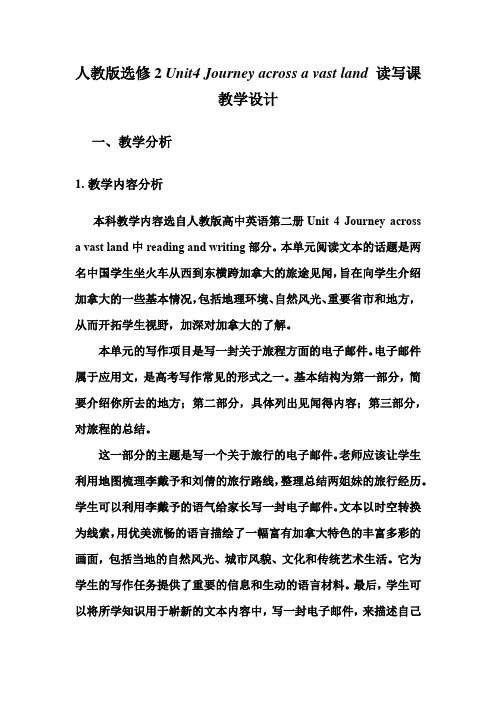
人教版选修2 Unit4 Journey across a vast land 读写课教学设计一、教学分析1.教学内容分析本科教学内容选自人教版高中英语第二册Unit 4 Journey across a vast land中reading and writing部分。
本单元阅读文本的话题是两名中国学生坐火车从西到东横跨加拿大的旅途见闻,旨在向学生介绍加拿大的一些基本情况,包括地理环境、自然风光、重要省市和地方,从而开拓学生视野,加深对加拿大的了解。
本单元的写作项目是写一封关于旅程方面的电子邮件。
电子邮件属于应用文,是高考写作常见的形式之一。
基本结构为第一部分,简要介绍你所去的地方;第二部分,具体列出见闻得内容;第三部分,对旅程的总结。
这一部分的主题是写一个关于旅行的电子邮件。
老师应该让学生利用地图梳理李戴予和刘倩的旅行路线,整理总结两姐妹的旅行经历。
学生可以利用李戴予的语气给家长写一封电子邮件。
文本以时空转换为线索,用优美流畅的语言描绘了一幅富有加拿大特色的丰富多彩的画面,包括当地的自然风光、城市风貌、文化和传统艺术生活。
它为学生的写作任务提供了重要的信息和生动的语言材料。
最后,学生可以将所学知识用于崭新的文本内容中,写一封电子邮件,来描述自己最难忘的一次旅行经历。
2.学情分析教学设计的对象是普通高校的高中生,这篇文章的难度适中。
主要谈论了加拿大的自然人文风光,学生们对于这一话题非常感兴趣,这为本课的学习提供了有利条件。
此外,经过了初中阶段的英语学习,他们已经有了一定的应用文写作的基础以及应用能力。
通过前三课时的学习,学生对本单元的话题有了充分的认知,对相关话题的词汇已有一定的掌握,语言的实际运用能力也有了一定的提高,能够根据话题表达自己的观点态度。
但是很多学生很少接触加拿大地理文化方面的知识,不熟悉电子邮件的格式、句式,较难将学到的词句转换成自己的语言写进应用文写作中。
因此,教师应采取读写结合教学法,指导学生从结构、语言和内容三个视角解读该教材文本。
Unit 4 Learning about language 课件-高中英语人教版选择性必修第二册
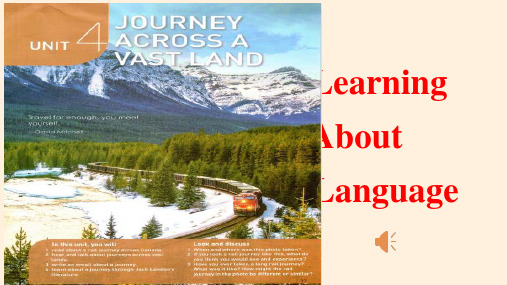
8 The beauty of Qinghai Lake took the visitors' __b_r_ea_t_h__ away. 9 In freezing cold winter, windows are often covered with __fr_o_s_t_. 10 We sailed into a beautiful __b_a_y___ in the southwest of Canada. 11 Judy enrolled in a programme of study that was eight months in _d_u_r_a_t_io_n____,but she completed it in only six months.
You: They must have spent a/an _p__le_a_s_a_n_t_ evening together.
2 Jane: We’re surprised to find that it is warmer than usual this winter in London.
You: You’re so lucky to have a/an __m_i_l_d__ winter here.
1.We became_e_x_c_i_t_e_d____ when thinking about those beautiful locations in Finland. We expected to experience a lot of e_x_c_i_t_in_g___
things there. 2. We went to bed as soon as we arrived at the hotel because we were
Unit4 History and Traditions教学设计高中英语人教版(2019)必修第二册
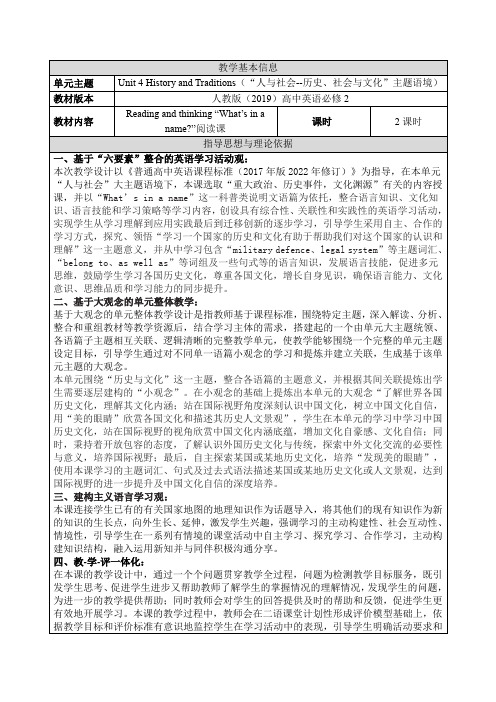
【主题大小观念】【语言大小观念】单元教学目标While-reading(57mins)First reading(49mins):·First paragraph(3mins):T will ask students to read the first paragraph and find out how can we solve the puzzle(“What is the relationship between these names?”) in this paragraph.T asks Ss what would the next paragraph talk about and Ss can share their thoughts.·Second paragraph(10mins):T asks Ss to scan paragraph 2 and asks do they notice their are many time tags there.Then T asks Ss paragraph 2 and draw a timeline based on it. After the reading, T will invite Ss share their answers. ·Group work1(6mins)T will ask Ss to form in a group of 4 and have a group work. The 4 should ask the next one a question about the timeline they have made in sequence.Then T will them ask Ss some questions to know whether they’ve known the development of the names. (Exp: What is the relationship between England and Britain; What parts does Great Britain contain...)·Third paragraph(4mins):T will use 56 ethics in China as an example and ask Ss are the 4parts(Scotland, England, North Ireland, Wales) of UK same in any aspects.T then asks Ss to read paragraph 3 and underline the differences and similarities of the 4 parts.·Forth paragraph(8mins):T will say “History can help us know the relationship of those names. And what else can history bring to us? What happened before the time of the united England?” and ask Ss to read paragraph 4. During the reading, Ss should finish the whole timeline on their paper. Then T will explain and check the timeline with Ss.·Group work 2(6mins):T will ask Ss to form in a group of 4 and have a group work. The 4 should ask the next one a question about the information in paragraph 4 in sequence.Then T will them ask Ss some questions to know whether they’ve known the development of the names. ·Pair work(7mins):T will ask Ss to have a pair work with their partner. The A will introduce the history from 1 th century to 11th century to B with the help of the timeline. After that, the B will introduce the history from 16th centuryplaces they think are interesting to the foreign friends mentioned above.。
Unit4 单元整体教学设计-高中英语人教版(2019)选择性必修第二册

Part 4: Teaching design:课时安排:小单元一
课时
第 1 课时
第 2 课时
内容
Opening Page Reading and Thinking(1)
课 型
学习目标
与主题相关的表达(单词+词块)
语法结构-ed/-ing
1. locate details about the rail
journey by skimming and
scanning the passage;
2. find discourse markers and
读思
understand them;
• structure features of journey
what, who, when, where, how, time
order
Part 4: Teaching design:单元学习目标
长途旅行贴近学生的生活。通过多模态语篇的学习,学生能够: 1. 获取、梳理、整合长途旅行主题相关的信息。 2. 巩固提高听、说、读、写技能。 3. 观察文本,辨别现在分词和过去分词,理解其功能和意义,并在
looking,
passing,
them to make a dialogue.
seen, amazed, rolling, confirming
Part 4: Teaching design:课时安排:小单元二
课时 内容
第 3 课时
Listening and Talking
语篇
Talk about scenery and culture along a journey
人教版高中英语教案Unit4Wildlifeprotection

英语必修二第四单元Unit 4 Wildlife protectionThe topic of this unit is wild life protection,which is very important everywhere. It is concerned with the importance of wildlife protection and ways to protect wild plants and animals. It introduces some of the animals to students that are in danger which helps them know the importance of protecting wild animals and plants on the earth.Daisy `s story shows the problems of wildlife protection in three parts of the world: Tibet, Africa and the Brazilian rain forest. It also shows us an organization (WWW) which works all over the world for the wildlife protection.Vocabulary: wild wildlife, protection, decrease, loss, reserve, hunt, zone, carpet, respond, distant, fur, relief, laughter, mercy, certain, importance, rub, mosquito, insert, contain, powerful, affect, attention, succeed, secure, income, employ, harm, bite, inspect, incident, dust, fierce, ending, die out, in peace, in danger, in relief, burst into laughter, protect… from…, pay attention to, come into being, according to, so that Functions:I`m going to……I feel like doing……I would rather not……..I intend / mean / plan to…..I would like to ……I will do ………I am ready to …Apologies:I am so sorry that …..I am afraid that……Thank you very much but…..It is a shame that ……It was very nice of you but ……Grammar: the present progressive passive voiceThe first period: Warming up, Pre-reading, Reading and ComprehendingAbility aims: Develop the students` reading ability to enable them learn about the knowledge of wildlife protection and talk about endangered species.Important points: Get the students to read the passage How Daisy Learned to HelpWildlife and learn different reading skills.Difficult points: Develop their reading ability and enable them to talk about wildlife protection fluently.Step 1 Warming upWarm up the students` interest about wildlife protection by showing some pictures and then answer some questions.1). Can you name at least eight kinds of animals which live in your neighborhood? What habits and characteristics do they have?2). What problems are some wild animals in China facing?3). What has China done to solve the problems?4). How have things changed since China took action to protect wild animal?5). Have you ever watched Tibet antelopes on TV? What problems are these animals facing? What measures has our government taken to protect them?Step 2 Reading1. Read the text aloud to the tape for the main idea, and then fill in the table.How Daisy Learned to help WildlifeThe text is made up of 4 paragraphs and can be divided into 4 partsType of writing A narrative writingPart 1 (para. 1) Daisy visited Tibet where antelopes have been over-hunted.Part 2 (para. 2) Daisy came to Zimbabwe where animals were being killed.Part 3 (para.3) Daisy arrived in a forest which needs to be protected.Part 4 (para.4) Daisy returned home / earning wildlife.2. Scan the text for detailed information to do the following questions.1). Paragraph 1 suggests that _____.A. the number of the antelopes in Tibet is getting smaller now.B. Daisy would like to see the antelopes very much.C. the antelopes have all been killed for the wool and none was leftD. the antelopes have moved from Tibet to some other places2). Paragraph 2 suggests that _____.A. farmers in Zimbabwe once made a living by huntingB. farmers are not satisfied with the governmentC. the living conditions of elephants in Zimbabwe have been improvedD. animals in Zimbabwe find it interesting to take photos with tourists3). Which of the following is not true according to the passage?A. Daisy know little about wildlife protection before the visitB. the endangered animals will disappear in the near futureC. the WWF is an organization whose duty is to protect wildlifeD. animals are being threatened in different ways4). Which is the most probable reason why the monkey in the forest are dying out?A. there are too many touristsB. they are being killed or huntedC. their habitats are being destroyedD. there is no enough food for them5). From the end of the story we can conclude that _____.A. the WWF will help Daisy to make the powerful drugB. the WWF has done little to protect wildlifeC. people will stop killing animals with the help of the WWFD. Daisy will continue to help protect wildlife by working with the WWF3. Read it carefully for the detailed information and then fill in the form.What did Daisy see where she was?In Tibet in China Zimbabwe In thick rain forest4.根据课文内容填空Character Means of transport AimDaisy Flying carpet To see some endangered wildlife.Daisy’s JourneyAnimals Places situationsAn antelope Tibet They are being killed for their soft fur.An elephant Zimbabwe They used to be an endangered s pecies because o ffarmers’ too much hunting.Their numbers are increasing because they getprotection from the government.A monkey A thick rain-forest The monkey is rubbing a (n) millipede insect overits body to protect itself from mosquitoes, whichshows plants, animals and human beings livetogether by supporting each other.5. Deal with language problems students meet while checking the answers. Find out the useful collocations in the passage.long to do, endangered species of wildlife, wake up, find ….by one`s bed, a flying carpet, fly away to, use …. to make …., kill…for…., as a result, turn around, take one`s photos, in relief, burst into laughter, used to be, without mercy, destroy one`s farms, allow sb. to do sth. a certain number of…., make money for…, in thick rain forest, protect…from…., rub…over…., a powerful drug, pay attention to, take …..home….., be able to…..6. Do the exercise 1 and 2 in comprehending on page 27.Step 3 Dialogue:Ask students to read the passage again and then let them write dialogues in groups.(1)Group 1 write a dialogue between Daisy and Chair;(2) Group 2 write one between Daisy and Antelope;(3) Group 3 write one between Daisy and Elephant;(4) Group 4 write one between Daisy and Monkey.Step 4 Practice and performLet them practice their dialogue impairs and then before the class.Step 5 Closing down by matching animals to 5risk categoriesDifferent endangered species appear on different endangered species lists. All people who are trying to protect animals use the following 5 risk categories to group the unlucky animals:List o Unlucky animals found in China(中国不幸动物分类名录)EXTINCT(灭绝动物)—A species formerly indigenous to China that no longer exists anywhere.EXTIRPATED(根绝动物)—A species no longer existing in the wild in China but occurring elsewhere.ENDANGERED(濒危动物)—A species threatened with imminent extinction or extirpation throughout all or a significant portion of its China`s range.THREATENED(危急动物)—A species likely to become endangered in China if the factors affecting its vulnerability are not reversed.VUNERABLE(弱势动物)—A species particularly at risk because o f low or declining numbers, small range or for some other reason, but not a threatened species.Step 6 homeworkFinish off the exercises in the textbook.Learn all the useful words and expressions by heart.The second period: Learning about important language pointsThe emphasis of this period will be place on the important new words, expressions and sentence patterns in the former parts.Knowledge aims:1). Learn and grasp the new words and expressions: wild, wildlife, protection, decrease, lose, reserve, hunt, zone, carpet, respond, distant, fur, relief, mercy, certain, importance, rub, mosquito, insert, contain, powerful, affect, attention, succeed, secure, income, employ, harm, bite, inspect, incident, dust, fierce, ending, die out, in peace, in danger, in relief, burst into laughter, protect… from…, pay attention to, come into being, according to, so that.2). Let the students learn the following sentence patterns:As a result, these endangered animals may even die out.This is what wildlife protection is all about.I wonder what is being done to help you.We are being killed for the wool beneath our stomachs.We used to be endangered species.But I would like to help as the WWF suggests.Ability aims: get the students to use some useful words and expressions a nd enable them to make sentences after the useful sentence patterns.Important points: learn and use the useful words and expressions correctly.Difficult points: how to help them learn and use the words and expressions correctlyand enable them to understand the difficult sentences.Step 1 revisionCheck the homework exercises.Ask some students to perform their text play.Step 2 Reading and findingRead through all parts to underline all the collocations: look after, a good environment, as a result, die out, endangered animals, wildlife protection, in peace, in danger, long to do,endangered species of wildlife, wake up, find by one`s bed, a flying carpet, fly away to, use …to make…., kill…..for…., turn around, take one`s photos, in relief, burst into laughter, used to be, without mercy, destroy one`s farm, allow sb. to do sth….., a certain number of, make money for, in thick rain forest, protect ….from…., rub….over….., a powerful drug, pay attention to, take ….home, be able to…, such as…, move into, be concerned about, do harm toStep 3 Practice for the useful words and expressionsTurn to page 28 to do exercise 1-3. then check with them all in class.Step 4 V ocabulary study1.as a result: because of something that has happenedHe had some bad fish. As a result, he felt ill this morning.As a result of his hard work, he got a pay rise.Thousands of people lost their homes as a result of the big fire.2. die out: disappear completelyMany animals have died out in the past few years.He hid behind the door until the footsteps had died away.3. in danger:His life is in danger.Why are some species in danger of disappearing?The river is dangerous for swimmers.This machine is dangerous: the wiring is fault.out of dangeron the danger list4. respond: give a verbal or written answer; act in answer to or because of the action of another; react quickly or favorably, be easily controlled.She asked where he had been, but he didn`t respond.He responded to my volleyball with a backhand.The car responds well to the controls.Animals respond to kindness.5. protect: keep sb. or sth. safe from harm, injury,etc. defend sb. or sth. against sth.Protect home industriesProtect somebody from dangerHe raised his arms to protect himself.6. contain: have or hold within itselfPig iron may contain 4% of carbon.The bottle contains two pints.7. affect: have an effect on;A sudden change in weather may affect your health.His opinions will not affect my decision.Did the medicine have any effect?8. pay attention toPay attention to these sentences from the interview.My mother asked me to pay attention to the traffic when crossing the road.catch / call / draw / attract / invite one`s attentionbe all attentiondevote / direct one`s attention tofocus / center one`s attention onpay special attention toStep 5 sentence focus1.Do you know any other endangered wildlife in China that is being protected?that is being protected 是定语从句They produced a new record in 1996, with which they celebrated their former time asa real band.2.Daisy had always longed to help endangered species of wildlife.I am long to see you again.The children are longing for the holidays.She longed for him to ask her to dance.3. Please take me to a distant land where I can find the animals that gave fur to make this sweater.where I can find the animals / that gave fur to make this sweater是定语从句4. Our fur is being used to make sweaters for people like you.be used to do sth. 被用来作什么be used to doing sth. 习惯做什么used to do sth. 过去常常做什么5. It shows the importance of wildlife protection, but I`d like to help as the WWF suggests.as the WWF suggests是方式状语从句6. You pay more attention to the forest where I live and appreciate how the animals live together.where I live是定语从句how the animals live together是宾语从句7. No rain forest, no animals and no drugs.If there is no rain forest, there will be no animals and no drugs.Step 6 Using words and expressionsTurn to page 63 and do the exercises.Step 7 HomeworkFinish off the Workbook exercises.Learn the new words and expressions by heart.The third period: Learning about grammarThis teaching period mainly deal with the grammar: the present progressive passive voice.Knowledge aims: get the students to know the structure of the present progressive passive voice.Difficult points: get them to know and use the grammar clearly.Important points: how to help them learn the grammar easily.Step 1 revision1. Check the homework exercises.2. Dictate some useful words and expressions.Step 2 Grammar revision1. The passive voice: passive subject + be + past participle ( only verbs that take an object can be used in the passive voice), which focus on the person or thing when affected by an action.2. Turn the following into passive voice:1). They make Fords in Cologne.2). I will finish it tomorrow.3). They are going to build a new factory in Portland.4). They have produced over 29 models in the past two years.Step 3 practice1). Ask them to do Exercise 2 on page 29.2). Ask them to do Exercise 1-2 on page 64.Step 4 Consolidation.1).Read the text to find the sentences which includes the present progressive voice.2). Turn the following into passive voice.1). They are producing a new drug.→________________________________.2). Antelopes are looking at her.-→_________________________________.3). They are killing us for the wool.→_________________________________.4). They are destroying the farm.→_________________________________.Step 5 Closing down by playing a game.Ask some students to say some sentences which contain the present progressive voice.Step 6 HomeworkFinish off the Workbook exercises.Do Exercise 1 on page 64 in your exercise book.The forth period:Using Language:Extensive reading In this period,the teaching emphasis will be put on developing students` reading ability by reading extensively. We will deal with two parts: the passage about dinosaurs in Using language on page 30 and Reading task on page 65.Knowledge aims: get the students to learn some useful new words and expressions in this part: dinosaur, inspect, incident, dust, fierce, come into being, according to. Get them to learn about dinosaurs and deer.Important points: develop students` reading skills by extensive reading and let them read the two reading passage.Difficult points: enable students to learn to use reading strategies such as skimming, scanning, and so on to get them to finish their reading task.Step 1 Revision1. Check the homework exercises.2. Revise the form of the present progressive passive voice: passive subject + be + past participleStep 2 Leading in by looking and talking1. Show them some pictures of milu deer and talk about them.The milu deer, also called David`s deer, is an animal formerly unique to China. Ancient Chinese characters “mi” was one of the first to be engraved on tortoise-shell and animal bones. Later, throughout various dynasties, the animal was bred in imperial parks but, tragically , by 1900 it had become extinct in China. But 100 years later, David`s deer has returned.A look back at the history shows that tens of thousands of years of civilization achieved by man have been the cost of our natural environment. The wetland, home for the Milu deer dubbed the kidneys of the world. But centuries of devastations have led to series of soil erosion, depriving wetland animals of their habitats and the environment of one of its vital functions. The return of milu deer to China is a reminder to the Chinese people of the need to protect our mother earth.Something about dinosaurs:Dinosaurs first appeared about 200 million years ago, many kinds of dinosaurs became extinct. Birds are a special type of dinosaur and they were the only kind to live until today. The largest dinosaurs were plant-eaters like Apatosaurus and brachiosaurus. They were the largest animals to ever walk on dry land.Step 3 reading1. Fast read to get the main idea. ( it is mainly about species and the reasons for dinosaurs` dying out.)2. Read and answer:1). When did the dinosaurs die out?2). What is the rare new species dinosaur do?3). What could the rare new species dinosaur do?4). Why did the dinosaur die out?3.Read the text again to find out the useful collocations: during the history of the earth,live on earth, tens of millions of years ago, come into being, eggs of five species, a rare new species, a bird-like dinosaur, climb tree, tell….from…., die out, hit the earth, put ….into the air, get hot, live on, know for sure, in the same way, listen to the story about, disappear fromStep 4 Reading taskTurn to page 65. First, read the title and guess the meaning. Then read it carefully to get the main idea.Information for research into the milu deerAppearanceFeaturesReasons fordisappearanceThe Milu deer in BritainHow they returnedPresent situationValue of the cooperationStep 5 closing down by retelling1. Ask students to read the passage The Return of the Milu Deer again and prepare their stories.2. Ask as many students as possible to come to the front to retell their story.Step 6 HomeworkFinish off the workbook exercises.Learn the useful new words and expressions in this part by heart.The fifth period: Using Language: Listening, Speaking and WritingThe emphasis of this period is the story of how the dodo disappeared forever. It is not a real story but it is possible that it happened this way.Knowledge aims: get the students to learn the expressions of intentions and apologies by listening and understanding the listening materials.Difficult points: develop students` listening ability.Important points: develop students` listening ability and enable them to learn and use the useful expressions.Step 1 Revision1. Check the homework exercises.2. Dictate some useful words and expressions.Step 2 Warming upShow them the picture of the dodo and talk about it.By 1681, the last dodo died, and the species became extinct and it was regarded as a myth invented by imaginative sailor. Until the 1900`s when the bones were found, dodo was believed to be true. Today the dodo bird is a symbol of the harm humans can bring to other living things if we are irresponsible.Step 3 listeningTurn to page 30. Go through the exercises with the students and make them know what to do.Play the tape for them to listen and get the main idea by making notes while listening to the text.Step 4 Speaking1. Show the students the form to help them understand.Intention PurposeI am going to Help the dodoI intend / mean / plan to Hide it in a raceI will Trap man as he kills a dodoI feel like Attacking man myselfI would like to Put man in a caveI am ready to Teach man how to be friendsI would rather not tell you What I think of man2. Get them talk about how to help dodo in pairs.Step 5 Writing1. Ask them to write a passage under the heading to make a plan.1. How to protect dodo from man Help him by attacking man so he will leave the dodo alone; build a trap to catch man; result: man will not want to attack the dodo any more.2. How to stop man from killing dodos Go to another island; hide the dodo; result: dodos will a calm and peaceful live3. How to teach man to hunt another animal Give man a meal of friend fish; encourage him to join you on a fishing expedition; result: man leave dodos alone.2. Ask some of them to read their writing out.Step 6 Closing down by talking1. Suppose a situation: a friend gives you a very expensive, fine wool sweater. You are unhappy about the present but you do not want to upset your friend. What would you do?Some useful expressions: I am so sorry that….., I am afraid that……., thank you very much but….., it is shame that….., it was very nice of you but….., I hate to have to say this but….., the problem is…., why didn`t you tell me that…..?2. Let them discuss in pairs and then write a dialogue.Step 7 HomeworkFinish off the homework exercises.Read the listening text and try to tell something about the dodo.The sixth period: Using Language: Listening, Speaking and WritingThe emphasis of this period is laid on developing students` integrative skills to test if they have mastered what they have learned.Ability aims: develop students` listening, speaking and writing ability by finishing the relative tasks.Difficult points: how to develop students` writing and speaking abilities.Important points: develop the students` writing and speaking abilities.Step 1 RevisionCheck the homework exercises.Ask some students to talk about dinosaurs and the dodo.Step 2 Warming upSaying that: Many people, especially young ones, are concerned about the environment and wonder what they can do about it. Now we are going to listen to a story which is about looking after the environment.Step 3 Listening on page 62Turn to page 62, listen to the material after going through the exercises.Step 4 Listening taskTurn to page 66. play the tape for them to listen three times.Step 5 Speaking taskTurn to page 66 and read the directions, and then discuss the questions in pairs:1. What else threatens birds besides oil pills?2. How can we help protect the birds?3. How can we help people understand the importance of protecting the environment so that birds can live in peace?Step 6 Writing taskLet them write a short passage of about 120 words on how to design a place for watching birds.Step 7 Homework1. Finish off the homework exercises.2. Write your letters in your own exercise book.补充练习一. Choose the best answers.1. I don`t like the way_____ you talk to your mother.A. whichB. /C. in thatD. what2. With the water in the lake rising fast, villages around are _____.A. in dangerB. dangerC. dangerousD. in dangerous3. This atlas _____ 40 mans, _____ 3 of the Great Britain.A. contains; includingB. includes; containingC. contains; containingD. includes; including4. She suggested _____ the Western Hill this Sunday.A. we pay a visitB. to visitC. a visit toD. we visiting5. The exciting performances attracted the passers-by` _____.A. noticeB. attentionC. patienceD. taste6. The aging population in China will be a great _____ on the whole society.A. effectB. advantageC. difficultyD. problem7. The commercial center _____ in the middle of the 1980s.A. came outB. came into beingC. came overD. came from8. All the newspaper reporters hurried to the airport, ____ that the pop star didn`t turn up at all.A. disappointing to findB. disappointed findingC. disappointing findingD. disappointed to find9. The food ------ at the moment is for dinner party.A. cookedB. to be cookedC. is being cookedD. being cooked10. ----Why have you come to work on foot today?----Well, my bike _____ and I hate taking a crowded bus.A. has been repairedB. is repairingC. will be repairedD. in being repaired11. ---- Have you got your test result?----Not yet. The papers ____.A. are not correctingB. have not correctedC. are still being correctedD. is being repaired12. ----Excuse me, what time is it now?----Sorry, my watch _____. It _____ at the shop.A. isn`t working; is being repairedB. doesn`t work; is being repairedC. isn`t working; is repairedD. doesn`t work; is repaired13. ----Have you moved your new house?----Not yet. The rooms _____.A. are being paintedB. are paintingC. are paintedD. are being painting14. A new cinema ______ here. They hope to finish it next month.A. will be builtB. is builtC. has been builtD. is being built15. Rain-forests _____ and burned at such a speed that they will disappear from the earth in the near future.A. cutB. are cutC. are being cutD. had been cut16. The number of the rhino ____ in the last two years after the volunteers’ hard working.A. have increasedB. are increasingC. has increasedD. is increasing17.---Have the teacher returned our papers?---Not yet. I guess they ___ now.A.have gradedB. are gradedC. are being gradedD. are graded18.The restaurant where we used to have dinner ____, so we have to go to another one tonight. A. is rebuilt B. is being rebuilt C. has been rebuilt D. was rebuilt19.----Can you borrow me your bike? I want to go to the supermarket.----Sorry, but now it ____.A.is being repairedB. is repairedC. was repairedD. had been repaired20.----Have our new neighbor moved in?---No. The house ____ and they have to wait for another two days.A.is paintedB. paintC. is being paintedD. had been painted21.According to the officials in the United Nations, the product ____ at several places in India and it will be on sale in one month.A.is being testedB. is testedC. has been testedD. has tested22.Because of the bad weather, we ave no idea when the project _____.A.Has been completedB. Will be completedC. Was completedD. Is being completed23.The new plan ____ at the meeting. And we may have a final decision soon.A.has discussedB. is discussedC. has been discussedD. are being discussed24.The habitats of these Milu deer ___ and one day they may disappear from our sight.A.Was destroyedB. DestroyedC. Will be destroyedD. Are being destroyed25.---How about the murder case that happened last afternoon?---One of the two murderers has been caught and ____ in the police station now.A. is being questionedB. is questioningC. has questionedD. has been questioned二. Fill in the blanks with the words and expressions given below. Use each only once and make changes where necessary.come into being, species, protect …. From…, in danger of, wild, care for, peace, set up, increase, pay attention to, protect, in peace, die out, unsuccessful, think of, dig out, in peace, in danger of, in relief, burst into laughter, protect...from, pay attention to, come into being, according to, so that1. This species of plant will die out, unless we take actions to protect it.2. They were wild with joy when their team won.3. He hoped that his country would always be at peace with all other countries.4. The technical cooperation and cultural exchange between the two countries are daily on the increase.5. He was wearing dark glasses to protect his eyes from the sun.6. He was unsuccessful in his attempt to climb the Mt Everest.7. This kind of bird is dying out in the world.8. Leave him in peace; he is trying to work.9. Our teachers always pay attention to combining theory with practice.10. His father gave him some capital to set him up in business.11. I wonder whether they will care for us all to go there.12. How many factory workers are in danger of losing their jobs.13. They huddled together in the corner to protect themselves from the wind.14. Dinosaurs lived on the earth tens of millions of years ago, long before humans came into being.15. We have to think of his health before we recommend him for the job.16. From this documentary we can learn when and how the universe came into being.17. Knowing the operation of the poor girl’s leg was performed successfully, all the people smiled in relief.18. Don’t ask me any questions again, please. Just let me work in peace, will you?。
Unit4HistoryAndTraditions学案 高中英语人教版(2019)必修第二册
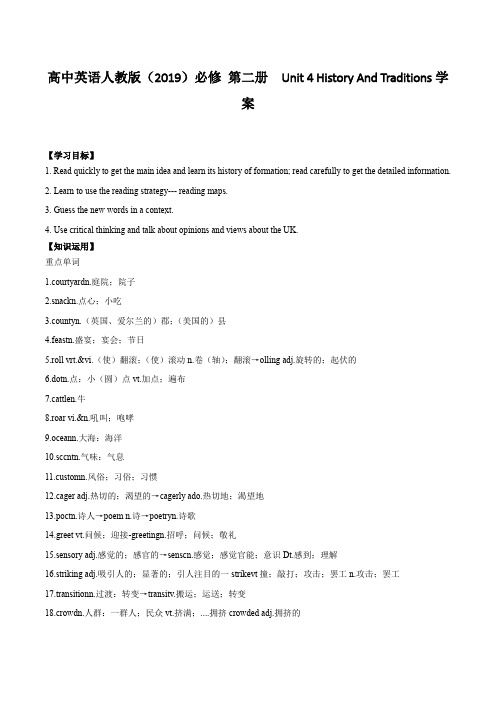
高中英语人教版(2019)必修第二册Unit 4 History And Traditions学案【学习目标】1. Read quickly to get the main idea and learn its history of formation; read carefully to get the detailed information.2. Learn to use the reading strategy--- reading maps.3. Guess the new words in a context.4. Use critical thinking and talk about opinions and views about the UK.【知识运用】重点单词1.courtyardn.庭院;院子2.snackn.点心;小吃3.countyn.(英国、爱尔兰的)郡;(美国的)县4.feastn.盛宴;宴会;节日5.roll vrt.&vi.(使)翻滚;(使)滚动n.卷(轴);翻滚→olling adj.旋转的;起伏的6.dotn.点:小(圆)点vt.加点;遍布7.cattlen.牛8.roar vi.&n.吼叫;咆哮9.oceann.大海:海洋10.sccntn.气味:气息11.customn.风俗;习俗;习惯12.cager adj.热切的;渴望的→cagerly ado.热切地;渴望地13.poctn.诗人→poem n.诗→poetryn.诗歌14.greet vt.问候;迎接-greetingn.招呼;问候;敬礼15.sensory adj.感觉的;感官的→senscn.感觉;感觉官能;意识Dt.感到;理解16.striking adj.吸引人的;显著的;引人注目的一strikevt撞;敲打;攻击;罢工n.攻击;罢工17.transitionn.过渡:转变→transitv.搬运;运送;转变18.crowdn.人群:一群人;民众vt.挤满;....拥挤crowded adj.拥挤的掌握规律巧记单词greeto.问候:迎接+ing→reetingn.招呼:问候:敬礼如:sailing 航海;航行skating 滑冰:溜冰sking 滑雪I I.核心短语1.have an influence on sth.对...影响2.a fcast for the cycs视觉盛宴3.be dotted with..布满:点缀4.make up组成5.more than很;非常6.be likely to do sth.可能做某事【阅读探究】What’s in a name?1.What are the four countries of the United Kingdom? Which two were the first to be joined together?2.According to the text, what are two chief advantages of studying the history of a country?3.What might “a name” here refer to?【句型梳理】1.So what is the difference between them, if any?如果有的话,那么他们之间的区别是什么?本句中if any是省略句,补全句子是:if there is any difference。
Unit4 Reading and Thinking -高中英语人教版(2019)选择性必修第二册

Homework:
Surf the Internet for more information about travelling in Canada;
Write your travel plan during winter vacation; Try to Vlog your travle experience and share it with your
Place
Winnipeg
Ontario
Lake Huron Toronto
what they did travel through the night;
what they saw how they felt
rolling hills; red, gold, and orange bushes and maple trees; frost on the ground; wide stretch of Lake Huron
3.“表递进” 增加更多的信息
besides in addition what is more moreover furthermore additionally
4.举例子
for example take ... as an example for instance
5. 表结果
what they did
what they saw how they felt
awesome, spectaucular
dear
grizzly bear
eagle
Place what they did
what they saw how they felt
Edmonton
went to the shopping mall
10 Book2 Unit4 -高一英语构词法及词性分类背诵与默写学案(人教版2019)

最新人教版高中英语必修二第四单元构词法及词性分类背诵与默写学案(背诵版)骆海燕编Unit 4 History and traditions派生词大集合:单元词汇按构词法分类记忆。
注:黑体部分为课标词和短语。
备注:1、不收录人名和地名。
2、单元大部分词汇按构词法分类记忆,其余的另外归类记忆。
Unit 4 History and traditions(背诵版)动词、名词、形容词、副词、短语归类复习(注意一个单词多种词性!动词为先!)
【练练基本功·课前练习】写出下列动词的过去式,过去分词,现在分词,第三人称单数。
(需特别注意
Unit 4 History and traditions(默写版)动词、名词、形容词、副词、短语归类复习(注意一个单词多种词性!动词为先!)
【练练基本功·课前练习】写出下列动词的过去式,过去分词,现在分词,第三人称单数。
(需特别注意动词不规则变形!)
最新人教版高中英语必修二第四单元构词法及词性分类背诵与默写学案(背诵版)骆海燕编Unit 4 History and traditions派生词大集合:单元词汇按构词法分类记忆。
注:黑体部分为课标词和短语。
备注:1、不收录人名和地名。
2、单元大部分词汇按构词法分类记忆,其余的另外归类记忆。
基于三维动态语法观的高中英语语法教学——以人教版选择性必修第二册Unit4JourneyAcross
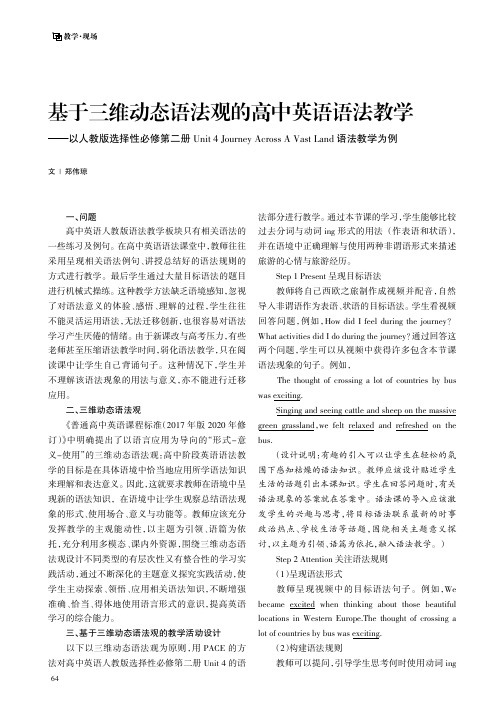
教学·现场一、问题高中英语人教版语法教学板块只有相关语法的一些练习及例句。
在高中英语语法课堂中,教师往往采用呈现相关语法例句、讲授总结好的语法规则的方式进行教学。
最后学生通过大量目标语法的题目进行机械式操练。
这种教学方法缺乏语境感知,忽视了对语法意义的体验、感悟、理解的过程,学生往往不能灵活运用语法,无法迁移创新,也很容易对语法学习产生厌倦的情绪。
由于新课改与高考压力,有些老师甚至压缩语法教学时间,弱化语法教学,只在阅读课中让学生自己背诵句子。
这种情况下,学生并不理解该语法现象的用法与意义,亦不能进行迁移应用。
二、三维动态语法观《普通高中英语课程标准(2017年版2020年修订)》中明确提出了以语言应用为导向的“形式-意义-使用”的三维动态语法观:高中阶段英语语法教学的目标是在具体语境中恰当地应用所学语法知识来理解和表达意义。
因此,这就要求教师在语境中呈现新的语法知识,在语境中让学生观察总结语法现象的形式、使用场合、意义与功能等。
教师应该充分发挥教学的主观能动性,以主题为引领、语篇为依托,充分利用多模态、课内外资源,围绕三维动态语法观设计不同类型的有层次性又有整合性的学习实践活动,通过不断深化的主题意义探究实践活动,使学生主动探索、领悟、应用相关语法知识,不断增强准确、恰当、得体地使用语言形式的意识,提高英语学习的综合能力。
三、基于三维动态语法观的教学活动设计以下以三维动态语法观为原则,用PACE的方法对高中英语人教版选择性必修第二册Unit4的语法部分进行教学。
通过本节课的学习,学生能够比较过去分词与动词ing形式的用法(作表语和状语),并在语境中正确理解与使用两种非谓语形式来描述旅游的心情与旅游经历。
Step1Present呈现目标语法教师将自己西欧之旅制作成视频并配音,自然导入非谓语作为表语、状语的目标语法。
学生看视频回答问题,例如,How did I feel during the journey?What activities did I do during the journey?通过回答这两个问题,学生可以从视频中获得许多包含本节课语法现象的句子。
Book2Unit4教学设计
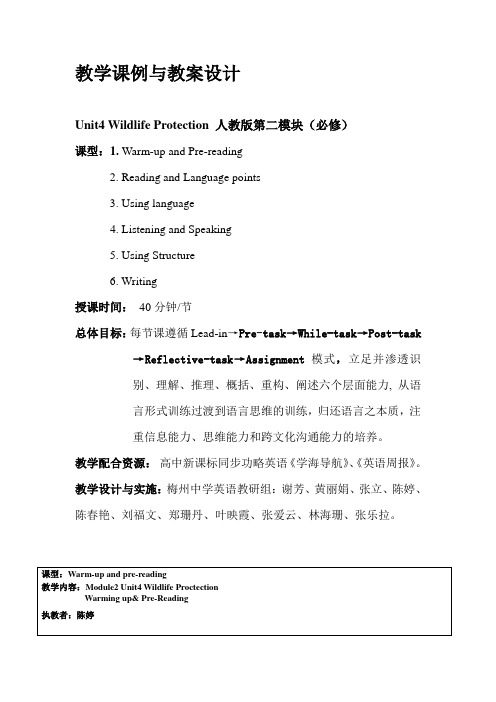
教学课例与教案设计Unit4 Wildlife Protection 人教版第二模块(必修)课型:1. Warm-up and Pre-reading2. Reading and Language points3. Using language4. Listening and Speaking5. Using Structure6. Writing授课时间:40分钟/节总体目标:每节课遵循Lead-in→Pre-task→While-task→Post-task →Reflective-task→Assignment模式,立足并渗透识别、理解、推理、概括、重构、阐述六个层面能力, 从语言形式训练过渡到语言思维的训练,归还语言之本质,注重信息能力、思维能力和跨文化沟通能力的培养。
教学配合资源:高中新课标同步功略英语《学海导航》、《英语周报》。
教学设计与实施:梅州中学英语教研组:谢芳、黄丽娟、张立、陈婷、陈春艳、刘福文、郑珊丹、叶映霞、张爱云、林海珊、张乐拉。
课型:Reading & language points 教学内容:Wildlife Protection SB2Attachment:Group work evaluation form (课堂小组活动评价表)C. Quite active and responsibleD. V ery active and needs improvement课型:Using language教学内容:Wildlife Protection 执教者:林海珊课型:Listening and speaking教学内容:Listening on Page 62&Page 65课型:Discovering useful structures教学内容:Present Continuous Passive Voice课型:Writing教学内容:How to write a basic writing of wildlife protection(根据SBP31写作任务改编)。
Unit 4 单词学案及当堂检测 2021-2022学年高中英语人教版(2019)必修第二册
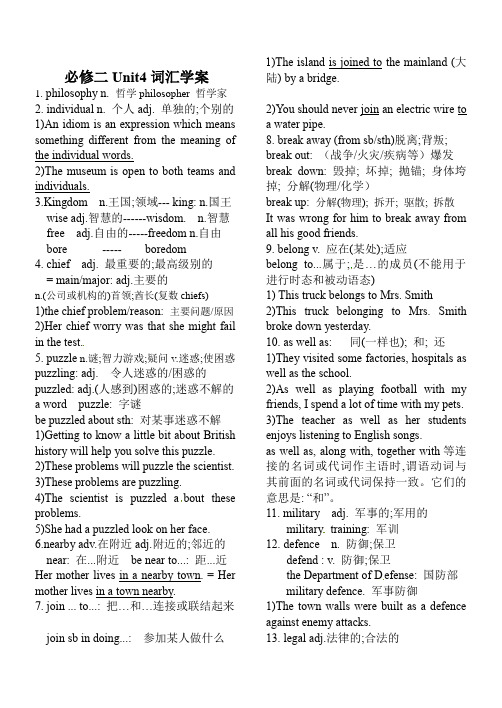
必修二Unit4词汇学案1.philosophy n. 哲学philosopher 哲学家2. individual n. 个人adj. 单独的;个别的1)An idiom is an expression which means something different from the meaning of the individual words.2)The museum is open to both teams and individuals.3.Kingdom n.王国;领域--- king: n.国王wise adj.智慧的------wisdom. n.智慧free adj.自由的-----freedom n.自由bore -----boredom4. chief adj. 最重要的;最高级别的= main/major: adj.主要的n.(公司或机构的)首领;酋长(复数chiefs)1)the chief problem/reason: 主要问题/原因2)Her chief worry was that she might fail in the test.5. puzzle n.谜;智力游戏;疑问v.迷惑;使困惑puzzling: adj. 令人迷惑的/困惑的puzzled: adj.(人感到)困惑的;迷惑不解的a word puzzle: 字谜be puzzled about sth: 对某事迷惑不解1)Getting to know a little bit about British history will help you solve this puzzle.2)These problems will puzzle the scientist.3)These problems are puzzling.4)The scientist is puzzled a bout these problems.5)She had a puzzled look on her face.6.nearby adv.在附近adj.附近的;邻近的near: 在...附近be near to...: 距...近Her mother lives in a nearby town. = Her mother lives in a town nearby.7. join ... to...: 把…和…连接或联结起来join sb in doing...: 参加某人做什么1)The island is joined to the mainland (大陆) by a bridge.2)You should never join an electric wire toa water pipe.8. break away (from sb/sth)脱离;背叛; break out: (战争/火灾/疾病等)爆发break down: 毁掉; 坏掉; 抛锚; 身体垮掉; 分解(物理/化学)break up: 分解(物理); 拆开; 驱散; 拆散It was wrong for him to break away from all his good friends.9. belong v. 应在(某处);适应belong to...属于;是…的成员(不能用于进行时态和被动语态)1) This truck belongs to Mrs. Smith2)This truck belonging to Mrs. Smith broke down yesterday.10. as well as: 同(一样也); 和; 还1)They visited some factories, hospitals as well as the school.2)As well as playing football with my friends, I spend a lot of time with my pets.3)The teacher as well as her students enjoys listening to English songs.as well as, along with, together with等连接的名词或代词作主语时,谓语动词与其前面的名词或代词保持一致。
Unit4 History and Traditions教学设计高中英语人教版(2019)必修第二册
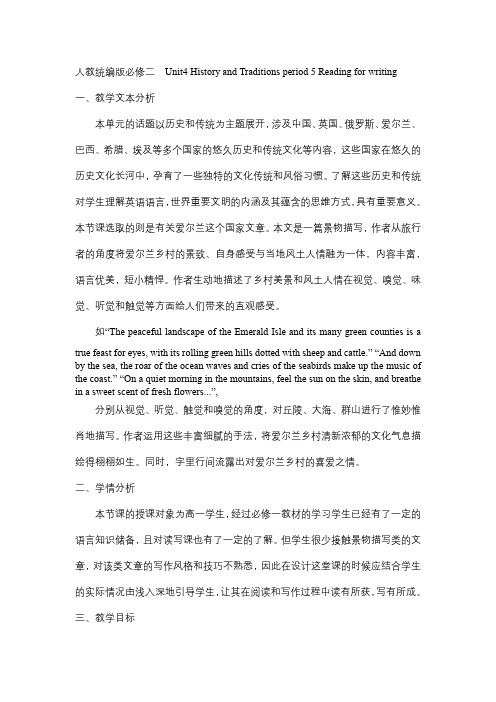
人教统编版必修二Unit4 History and Traditions period 5 Reading for writing一、教学文本分析本单元的话题以历史和传统为主题展开,涉及中国、英国、俄罗斯、爱尔兰、巴西、希腊、埃及等多个国家的悠久历史和传统文化等内容,这些国家在悠久的历史文化长河中,孕育了一些独特的文化传统和风俗习惯。
了解这些历史和传统对学生理解英语语言,世界重要文明的内涵及其蕴含的思维方式,具有重要意义。
本节课选取的则是有关爱尔兰这个国家文章。
本文是一篇景物描写,作者从旅行者的角度将爱尔兰乡村的景致、自身感受与当地风土人情融为一体,内容丰富,语言优美,短小精悍。
作者生动地描述了乡村美景和风土人情在视觉、嗅觉、味觉、听觉和触觉等方面给人们带来的直观感受。
如“The peaceful landscape of the Emerald Isle and its many green counties is atrue feast for eyes, with its rolling green hills dotted with sheep and cattle.” “And down by the sea, the roar of the ocean waves and cries of the seabirds make up the music of the coast.” “On a quiet morning in the mountains, feel the sun on the skin, and breathe in a sweet scent of fresh flowers...”,分别从视觉、听觉、触觉和嗅觉的角度,对丘陵、大海、群山进行了惟妙惟肖地描写。
作者运用这些丰富细腻的手法,将爱尔兰乡村清新浓郁的文化气息描绘得栩栩如生。
同时,字里行间流露出对爱尔兰乡村的喜爱之情。
- 1、下载文档前请自行甄别文档内容的完整性,平台不提供额外的编辑、内容补充、找答案等附加服务。
- 2、"仅部分预览"的文档,不可在线预览部分如存在完整性等问题,可反馈申请退款(可完整预览的文档不适用该条件!)。
- 3、如文档侵犯您的权益,请联系客服反馈,我们会尽快为您处理(人工客服工作时间:9:00-18:30)。
教案设计
四、教学方法
1.自主学习:让学生课前预习,自主查找与本课时相关的容。
2.合作探究:小组合作从网络上查找关于野生动植物的图片和资料,帮助他们熟悉话题以便于他们在学习过程中积极参与和主动探索。
3.结合多媒体技术,采用资源式、探究式的教学方法;注重交际活动,实施开放性讨论
五、教学过程
Step 1 Words preview
1._______far away in space or time
2. ___________to go down to a lower level
3. _________to do something to make a change
4. ________able to control events
5. _________打猎,猎取,搜寻
6. __________鉴赏,感激意识到
7. ____________保护…不受…伤害
8._________ 回答,响应
Step 2 Leading-in
1. Show a shot move about Wildlife Protection 成龙呼吁保护野生动物公益广
告成龙呼吁保护野生动物公益广告(英语) - 视频 - 优酷视频 - 在线观看
2. Have them in pairs discuss why they are endangered and show students some pictures.
Step 3 Pre-reading
Show students some information about wildlife protection from the Internet and ask students to discuss the following questions in pairs,
1. What is wildlife protection about?
2. What endangered species do you know?
3. Why are they in danger of disappearing?
Step 4 Fast reading
1.Read the passage quickly, and finish the main idea .
Daisy took _____________to travel and talked with ____________ in her dream,
本课Reading讲述的是一篇童话故事——Daisy乘坐飞毯跨越时空和藏羚羊、大象、猴子对话的神奇经历。
通过故事,帮助学生逐渐认识到保护野生动物的重要性,并了解该如何保护野生动物,号召人们热爱动物,保护动物,从我做起。
在本单元中,Reading前面的Warming up及pre-reading是该部分的铺垫,后面的listening, speaking等几部分都是Reading的延伸和扩展。
所以说Reading部分承载了本单元的主要信息,又集中了大量的有用词汇和语言结构,起到承上启下的作用。
(根据教学大纲及新课程的要求,确立了本课的教学目标及教学重难点。
)
2、教学目标
(1)认知目标
a、重点词汇和短语:wild, wildlife, protection, decrease, loss, reserve, hunt, zone, peace, respond,
distant, mercy, importance, powerful, affect, attention, appreciate, secure, die
out, in peace, in danger of, in relief, burst into laughter, protect…from…, pay
attention to
b、重点句式:Daisy had always longed to help endangered species of wildlife. (L.1)
I’m protecting myself from mosquitoes. (L.28)
No rainforest, no animals, no drugs. (L. 31)
But what an experience! (L.35)
(2)技能目标
•通过阅读,训练学生获取语篇信息、分析、处理、利用信息的能力;
•掌握猜测、略读、扫读的阅读技巧;
•掌握如何保护野生动物的知识;
•培养学生口头表达能力。
(3)情感目标
让学生学会如何保护野生动物,进一步意识到野生动物的生存环境日益恶化以及保护野生动物的行动刻不容缓。
3、教学重、难点
•让学生了解野生动物保护的知识;
•提高学生的阅读能力。
二、说学情
新课程强调“以人为本,以学生为主体”的教学思想。
那么作为一名合格的教师,了解学生是我们最基本的职责。
作为高中阶段的学生对周围的事物较为敏感,有自己的观点和看法,他们不满足于教科书上的知识,想获得更多的信息。
在英语学习上,他们不只是想把英语作为一门死记硬背的课程来学,更希望能学到知识性和趣味性兼有的容,从英语学习中获得更多的知识和能力。
但是他们的词汇量是有限的,并且缺乏阅读技巧。
且从学生学习语言的规律来看,高一年级是学生的阅读能力提高的重要阶段。
而从以往普通班的教学来看,学生在阅读一篇300字以上的文章时,阅读速度较慢,有许多不好的习惯,如逐字阅读,朗读式阅读等等。
其次,他们的理解正确率往往低于70%。
三、说教法
根据学生学习的实际情况确定教学活动的难度,即因材施教,是新课程理念下对英语教学最基本的要求。
那么依据学生实际情况,结合本单元的主题及本课的容,为突出重难点,以达到预定的教学目标,我采用了“导、读、练、说”的整体课文阅读教学法,即在老师的引导下,学生的自主阅读和训练。
从而激发学生兴趣,主动学习,学有所获。
1、任务型教学法
六、说板书设计
板书容包括了While-reading 中每一任务的问题答案。
通过图表式的板书,让学生对文章容一目了然,最终实现学生对信息的梳理,归纳和总结,使其的知识得到强化和巩固。
分享到:
上一篇:高三英语总复习二轮复习的做法 下一篇:高中英语研修学习心得
wildlife as possible.
了社会。
How Daisy learned to help wildlife
Main idea Daisy took a flying carpet to travel and talked with some animals in her dream, which made her know the importance of the wildlife protection.
Para.
Places
Animals
Situations
Feelings
1
Tibet
Antelope
They are killed for wool and their fur is used
to make sweater.
Sad 2
Zimbabwe
Elephant
Farmers used to hunt them but now the government
helps and the farmers who make money from tourism protect them.
Happy 3 Rainforest
Monkey
No rainforest, no animals and no drugs.
Amazed 4
Daisy returned home.。
